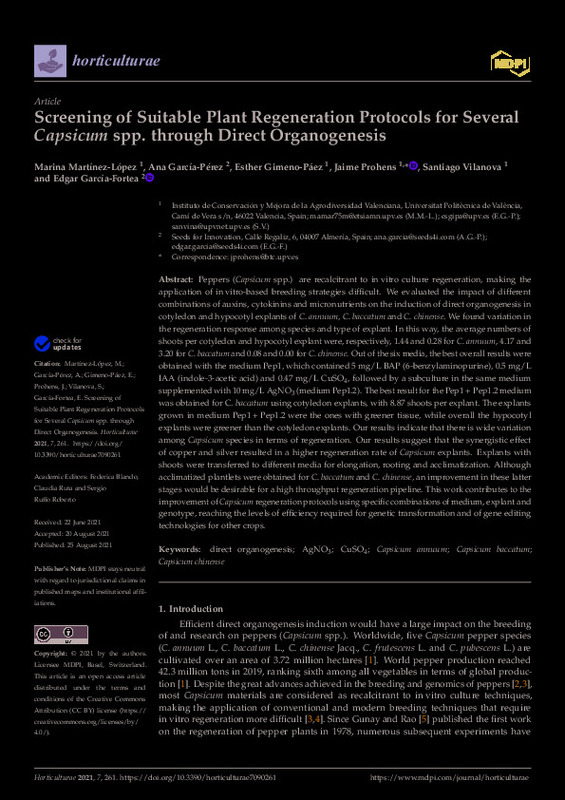JavaScript is disabled for your browser. Some features of this site may not work without it.
Buscar en RiuNet
Listar
Mi cuenta
Estadísticas
Ayuda RiuNet
Admin. UPV
Screening of Suitable Plant Regeneration Protocols for Several Capsicum spp. through Direct Organogenesis
Mostrar el registro sencillo del ítem
Ficheros en el ítem
| dc.contributor.author | Martínez-López, Marina
|
es_ES |
| dc.contributor.author | García-Pérez, Ana
|
es_ES |
| dc.contributor.author | Gimeno -Páez, Esther
|
es_ES |
| dc.contributor.author | Prohens Tomás, Jaime
|
es_ES |
| dc.contributor.author | Vilanova Navarro, Santiago
|
es_ES |
| dc.contributor.author | García-Fortea, Edgar
|
es_ES |
| dc.date.accessioned | 2022-06-30T18:07:42Z | |
| dc.date.available | 2022-06-30T18:07:42Z | |
| dc.date.issued | 2021-09 | es_ES |
| dc.identifier.uri | http://hdl.handle.net/10251/183720 | |
| dc.description.abstract | [EN] Peppers (Capsicum spp.) are recalcitrant to in vitro culture regeneration, making the application of in vitro-based breeding strategies difficult. We evaluated the impact of different combinations of auxins, cytokinins and micronutrients on the induction of direct organogenesis in cotyledon and hypocotyl explants of C. annuum, C. baccatum and C. chinense. We found variation in the regeneration response among species and type of explant. In this way, the average numbers of shoots per cotyledon and hypocotyl explant were, respectively, 1.44 and 0.28 for C. annuum, 4.17 and 3.20 for C. baccatum and 0.08 and 0.00 for C. chinense. Out of the six media, the best overall results were obtained with the medium Pep1, which contained 5 mg/L BAP (6-benzylaminopurine), 0.5 mg/L IAA (indole-3-acetic acid) and 0.47 mg/L CuSO4, followed by a subculture in the same medium supplemented with 10 mg/L AgNO3 (medium Pep1.2). The best result for the Pep1 + Pep1.2 medium was obtained for C. baccatum using cotyledon explants, with 8.87 shoots per explant. The explants grown in medium Pep1 + Pep1.2 were the ones with greener tissue, while overall the hypocotyl explants were greener than the cotyledon explants. Our results indicate that there is wide variation among Capsicum species in terms of regeneration. Our results suggest that the synergistic effect of copper and silver resulted in a higher regeneration rate of Capsicum explants. Explants with shoots were transferred to different media for elongation, rooting and acclimatization. Although acclimatized plantlets were obtained for C. baccatum and C. chinense, an improvement in these latter stages would be desirable for a high throughput regeneration pipeline. This work contributes to the improvement of Capsicum regeneration protocols using specific combinations of medium, explant and genotype, reaching the levels of efficiency required for genetic transformation and of gene editing technologies for other crops. | es_ES |
| dc.description.sponsorship | This research was funded by Universitat Politecnica de Valencia, research line 20200268. | es_ES |
| dc.language | Inglés | es_ES |
| dc.publisher | MDPI AG | es_ES |
| dc.relation.ispartof | Horticulturae | es_ES |
| dc.rights | Reconocimiento (by) | es_ES |
| dc.subject | Direct organogenesis | es_ES |
| dc.subject | AgNO3 | es_ES |
| dc.subject | CuSO4 | es_ES |
| dc.subject | Capsicum annuum | es_ES |
| dc.subject | Capsicum baccatum | es_ES |
| dc.subject | Capsicum chinense | es_ES |
| dc.subject.classification | GENETICA | es_ES |
| dc.title | Screening of Suitable Plant Regeneration Protocols for Several Capsicum spp. through Direct Organogenesis | es_ES |
| dc.type | Artículo | es_ES |
| dc.identifier.doi | 10.3390/horticulturae7090261 | es_ES |
| dc.relation.projectID | info:eu-repo/grantAgreement/UPV//20200268/ | es_ES |
| dc.rights.accessRights | Abierto | es_ES |
| dc.contributor.affiliation | Universitat Politècnica de València. Instituto Universitario de Conservación y Mejora de la Agrodiversidad Valenciana - Institut Universitari de Conservació i Millora de l'Agrodiversitat Valenciana | es_ES |
| dc.contributor.affiliation | Universitat Politècnica de València. Departamento de Biotecnología - Departament de Biotecnologia | es_ES |
| dc.description.bibliographicCitation | Martínez-López, M.; García-Pérez, A.; Gimeno -Páez, E.; Prohens Tomás, J.; Vilanova Navarro, S.; García-Fortea, E. (2021). Screening of Suitable Plant Regeneration Protocols for Several Capsicum spp. through Direct Organogenesis. Horticulturae. 7(9):1-17. https://doi.org/10.3390/horticulturae7090261 | es_ES |
| dc.description.accrualMethod | S | es_ES |
| dc.relation.publisherversion | https://doi.org/10.3390/horticulturae7090261 | es_ES |
| dc.description.upvformatpinicio | 1 | es_ES |
| dc.description.upvformatpfin | 17 | es_ES |
| dc.type.version | info:eu-repo/semantics/publishedVersion | es_ES |
| dc.description.volume | 7 | es_ES |
| dc.description.issue | 9 | es_ES |
| dc.identifier.eissn | 2311-7524 | es_ES |
| dc.relation.pasarela | S\461413 | es_ES |
| dc.contributor.funder | Universitat Politècnica de València | es_ES |
| dc.subject.ods | 02.- Poner fin al hambre, conseguir la seguridad alimentaria y una mejor nutrición, y promover la agricultura sostenible | es_ES |
| upv.costeAPC | 1694 | es_ES |








